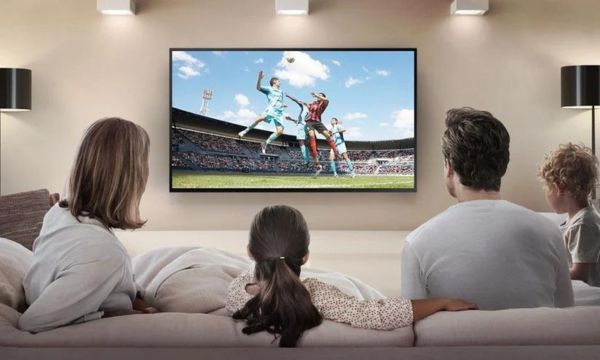Immersive Entertainment: A Smart TV Guide
Home entertainment is constantly changing, but smart TVs are in the spotlight, changing the way we watch shows and movies.
These smart devices easily combine a standard TV with internet access and are equipped with many options to make watching TV even more fun.
Our goal with this guide is to help you understand all the different parts of a smart TV so you can choose the one that best suits your entertainment needs.
1. Understanding Smart TVs:
Smart TVs are more than regular TVs; they open the door to a world of digital materials and connections.
Since these devices have built-in internet access, users can stream content from well-known services such as Netflix, Hulu, and YouTube directly to the TV screen.
Smart TVs also often have advanced operating systems such as Android TV, Tizen, or webOS, making them easy to use and giving you access to many apps.
2. Understanding Display Technology:
To get the most out of your smart TV, you need to understand display technology. Some common display technologies include LED, OLED, QLED, and NanoCell. Each has its advantages.
LED TVs have bright screens and use very little power, while OLED TVs have the best contrast and deepest blacks.
QLED and NanoCell TVs improve color accuracy and brightness, so they can be used in different environments and by people with different tastes.
3. Screen Size and Quality:
Choosing the right screen size and resolution is important if you want to enjoy an immersive experience. Consider the size of your viewing area and optimal viewing distance.
Also, pay attention to the quality of your TV. You can choose from Full HD (1080p), 4K Ultra HD and 8K. Higher resolution images are sharper, but material in these formats should suit your tastes and be compatible with your source.
4. Improvements to the Sound and Sound System:
The sound capabilities of a smart TV are important in making the experience feel like watching a movie.
For music that surrounds you, look for features like Dolby Atmos and DTS: X. Some smart TVs can also be connected to an external sound system or soundbar, which can improve the quality and depth of your music.
Understanding the available audio enhancements can help you enjoy your entertainment environment.
5. Connection Method and Port:
See your smart TV’s ports and how to connect to other devices. To connect external devices such as a game console, Blu-ray player, or sound system, you need an HDMI port.
Entertainment hubs with USB ports, Ethernet ports, and wireless options make it flexible and easy to connect to other devices.
6. Software and Apps for Smart TVs:
The interfaces and applications that run on a smart TV are set by the system it runs on. People often choose between Android TV, Tizen, or webOS, each of which offers a different experience for users.
Make sure your Smart TV works with the services and apps you use most so you can enjoy a unified, smooth viewing experience.

Immersive-Entertainment-A-Smart-TV-Guide (Source – Google)
Conclusion
There are many things to consider when buying a smart TV to ensure you have a personalized and immersive viewing experience.
Choosing between all the different monitor technologies, audio enhancements and operating systems can be difficult.
Knowing what you want, how much space you have, and what features you want can help you make an informed choice that meets your entertainment needs.
Smart TVs are more than just gadgets; they open up a world of possibilities by combining traditional TV with the digital age. This creates an unparalleled viewing experience.
FAQs
1. What does a smart TV do?
A smart TV is a TV that is connected to the Internet and has a built-in software platform that allows users to view online content, streaming services, and apps directly from the TV.
2. How does a smart TV differ from a regular TV?
Smart TVs differ from regular TVs because they have a built-in internet and operating system.
This means they can stream content from online platforms, download apps, and make TV viewing more interactive and connected.
3. What are the well-known smart TV operating systems?
Android TV, Tizen, webOS, and other popular operating systems are used on smart TVs. These systems have user-friendly screens and can run many different programs.
4. What display system do most smart TVs use?
LED, OLED, QLED, and NanoCell are all common display technologies found in smart TVs. Each technology has its advantages, such as using less energy, producing deep blacks, bright colors, and better contrast.
5. How do you choose the right smart TV screen size?
Consider the size of your viewing area and optimal viewing distance. In general, choose a screen size that gives you a realistic experience without straining your eyes.
6. What does screen size mean for a smart TV?
The clarity of the image depends on the screen resolution, which can be Full HD (1080p), 4K Ultra HD, or 8K.
The higher the resolution, the more detailed, but the source of the material must be able to handle the resolution you choose.
 Climate Control Revolution: Embracing the Future with Smart Thermostats
Climate Control Revolution: Embracing the Future with Smart Thermostats
As new technologies change every aspect of our lives, smart thermostats have become an important part of […]
More Enhancing Security with Smart Doorbell Cameras
Enhancing Security with Smart Doorbell Cameras
In an era of constant technological advancement, smart products are becoming more and more common in our […]
More Illuminate Your Space: Motion Sensor Lights
Illuminate Your Space: Motion Sensor Lights
Motion sensor lights are one of the most useful and creative forms of modern lighting. They can […]
More